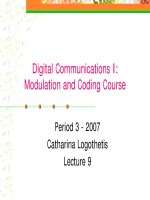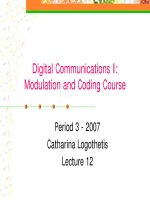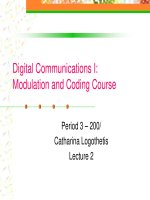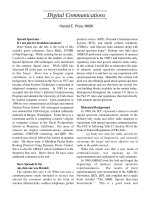Digital Communications I: Modulation and Coding Course
Bạn đang xem bản rút gọn của tài liệu. Xem và tải ngay bản đầy đủ của tài liệu tại đây (744.9 KB, 30 trang )
Digital communications I:
Modulation and Coding Course
Period 3 - 2007
Catharina Logothetis
Lecture 6
Lecture 6 2
Last time we talked about:
Signal detection in AWGN channels
Minimum distance detector
Maximum likelihood
Average probability of symbol error
Union bound on error probability
Upper bound on error probability based
on the minimum distance
Lecture 6 3
Today we are going to talk about:
Another source of error:
Inter-symbol interference (ISI)
Nyquist theorem
The techniques to reduce ISI
Pulse shaping
Equalization
Lecture 6 4
Inter-Symbol Interference (ISI)
ISI in the detection process due to the
filtering effects of the system
Overall equivalent system transfer function
creates echoes and hence time dispersion
causes ISI at sampling time
)()()()( fHfHfHfH
rct
=
i
ki
ikkk
snsz
∑
≠
++=
α
Lecture 6 5
Inter-symbol interference
Baseband system model
Equivalent model
Tx filter
Channel
)(tn
)(tr
Rx. filter
Detector
k
z
kTt =
{ }
k
x
ˆ
{}
k
x
1
x
2
x
3
x
T
T
)(
)(
fH
th
t
t
)(
)(
fH
th
r
r
)(
)(
fH
th
c
c
Equivalent system
)(
ˆ
tn
)(
tz
Detector
k
z
kTt =
{ }
k
x
ˆ
{}
k
x
1
x
2
x
3
x
T
T
)(
)(
fH
th
filtered noise
)()()()( fHfHfHfH
rct
=
Lecture 6 6
Nyquist bandwidth constraint
Nyquist bandwidth constraint:
The theoretical minimum required system bandwidth to
detect Rs [symbols/s] without ISI is Rs/2 [Hz].
Equivalently, a system with bandwidth W=1/2T=Rs/2
[Hz] can support a maximum transmission rate of
2W=1/T=Rs [symbols/s] without ISI.
Bandwidth efficiency, R/W [bits/s/Hz] :
An important measure in DCs representing data
throughput per hertz of bandwidth.
Showing how efficiently the bandwidth resources are
used by signaling techniques.
Hz][symbol/s/ 2
22
1
≥⇒≤=
W
R
W
R
T
ss
Lecture 6 7
Ideal Nyquist pulse (filter)
T2
1
T2
1−
T
)( fH
f
t
)/sinc()( Ttth =
1
0
T
T2
T−
T2−
0
T
W
2
1
=
Ideal Nyquist filter Ideal Nyquist pulse
Lecture 6 8
Nyquist pulses (filters)
Nyquist pulses (filters):
Pulses (filters) which results in no ISI at the
sampling time
.
Nyquist filter:
Its transfer function in frequency domain is
obtained by convolving a rectangular function with
any real even-symmetric frequency function
Nyquist pulse:
Its shape can be represented by a sinc(t/T)
function multiply by another time function.
Example of Nyquist filters: Raised-Cosine filter
Lecture 6 9
Pulse shaping to reduce ISI
Goals and trade-off in pulse-shaping
Reduce ISI
Efficient bandwidth utilization
Robustness to timing error (small side
lobes)
Lecture 6 10
The raised cosine filter
Raised-Cosine Filter
A Nyquist pulse (No ISI at the sampling time)
⎪
⎪
⎩
⎪
⎪
⎨
⎧
>
<<−
⎥
⎦
⎤
⎢
⎣
⎡
−
−+
−<
=
Wf
WfWW
WW
WWf
WWf
fH
||for 0
||2for
2||
4
cos
2||for 1
)(
0
0
0
2
0
π
Excess bandwidth:
0
WW −
Roll-off factor
0
0
W
WW
r
−
=
10 ≤≤ r
2
0
0
00
])(4[1
])(2cos[
))2(sinc(2)(
tWW
tWW
tWWth
−−
−
=
π
Lecture 6 11
The Raised cosine filter – cont’d
2
)1( Baseband
sSB
s
R
rW +=
|)(||)(| fHfH
RC
=
0=r
5.0
=r
1=r
1=r
5.0=r
0=r
)()( thth
RC
=
T2
1
T4
3
T
1
T4
3−
T2
1−
T
1−
1
0.5
0
1
0.5
0
T
T2
T3
T−
T2−
T3−
s
RrW )1( Passband
DSB
+=
Lecture 6 12
Pulse shaping and equalization to
remove ISI
Square-Root Raised Cosine (SRRC) filter and Equalizer
)()()()()(
RC
fHfHfHfHfH
erct
=
No ISI at the sampling time
)()()()(
)()()(
SRRCRC
RC
fHfHfHfH
fHfHfH
tr
rt
===
=
Taking care of ISI
caused by tr. filter
)(
1
)(
fH
fH
c
e
=
Taking care of ISI
caused by channel









